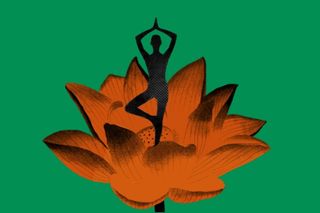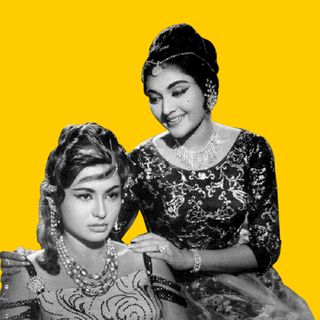
How Did Yoga Become Soft Power?
Yoga’s popularity sparks debates about the thinning line between its promotion for physical wellbeing and its association with Hindutva.

Yoga is rapidly gaining popularity as a means to achieve ultimate physical and mental wellbeing; its global explosion as a cultural export from India has been decades in the making. This year, both India’s health minister, Mansukh Mandaviya, and the minister of state for external affairs and culture, Meenakshi Lekhi, admitted to yoga’s rising prominence as a form of India’s soft power, with the latter calling the practice “an Indian tradition that we gifted the world.”
Indeed, since coming to power in 2014, the Narendra Modi-led government has embraced yoga as a soft power asset — consolidating its global presence by persuading the UN to recognize an “International Day of Yoga,” which it finally did in December 2014 through a unanimous resolution.
“Soft power, in the post-Cold War era, is a crucial component of foreign policy, and India draws on its rich tradition and heritage — including Bollywood movies, yoga, ayurvedic medicine, heritage tourism, and distinctive, spice-rich cuisine — to exercise it,” explains an article on The Loop. Why, among all of these, has yoga emerged at the forefront of India’s soft power, though? “A potent medium for promoting the Indian way of life, yoga helps project an image of India as a peaceful country that refrains from aggression. In a foreign policy context, harnessing the holistic power of yoga helps cultivate other countries’ goodwill,” the article continues.
The deadly global pandemic further boosted yoga‘s global appeal due to an increased sense of health consciousness. “Post-Covid19, people have become more aware of their health and wellness. Because of this, yoga’s relevance and popularity has also increased substantially,” Mandaviya said.
But the rise of yoga as India’s soft power has been more strategic than an accidental crisis. When Western celebrities caught wind of yoga and spirituality in the 60s and beyond — most notably, when The Beatles visited Maharishi Mahesh Yogi in Rishikesh — yoga became a cultural symbol that aligned with the “peace and love” hippie movement in the West at the time. Soon, however, Americans embracing yoga led to a reciprocal backlash from Indians — especially the non-residential ones settled abroad — who sought to reclaim the tradition as Hindu, alleging the cultural appropriation of the practice. This, in turn, paved the way for the Indian government to blend both perceptions — promoting yoga both as a spiritual wellbeing tool, and as part of ancient Hindu culture.
Related on The Swaddle:
Our Obsession With Every Cannes Look Reveals Our Need for Validation From the West
Meanwhile, yoga‘s flourishing renown as a tool of India’s soft power has continued to spark a debate about the thinning line between its promotion for physical wellbeing and its forced association with Hindu nationalist ideas. In fact, India’s appeal to have June 21, specifically, declared as the International Day of Yoga is also reported to be driven by Hindu mythology.
“Despite originating in ancient India, yoga in more recent decades has gained traction as a secularized practice of health and wellbeing in Western countries,” Afeeya Akhand wrote in SAARI last year. “[But] the use of yoga as a symbol of India’s peaceful and harmonious nature has [also] drawn criticism. Due to yoga’s ancient ties to religions such as Hinduism, critics [believe] that yoga is a form of propaganda to justify and celebrate the growing domestic climate of Hindu nationalism under Modi.”
Yoga‘s physical benefits are endorsed by doctors, too, who believe it “can be an extremely useful lifestyle tool for patients seeking to improve fitness and develop a mindfulness-based practice.” However, despite its broad global appeal as a wellness device, its religious heritage remains an integral part of its potential as a political tool. The challenge, then, arises when the spiritual aspect of yoga is co-opted by religious groups to promote exclusive religious ideologies — often tied to the Hindu nationalist agenda — creating tension between yoga‘s universal message of wellbeing and its potential political connotations.
“Hindu nationalists weaponize yoga, using it to appear benevolent, modern, and to disguise their political mission and global ambition,” Angana Chatterji, an Indian anthropologist, activist, and feminist historian, told The Nation. “They reduce yoga’s complex formative history to promote the ideals of Brahminical Hinduism, appropriating and erasing yoga’s connections to Buddhist, Sufi, Jain, and Tantric traditions in South Asia.”
Some critics of the government have also accused it of commercializing the practice to serve their vested interests. “[Promotion of yoga] could stabilize the urban middle class support for the saffron brigade. Followers of yoga gurus tend to be mesmerised by them and are often influential and wealthy… In return for the BJP government’s endorsement, the yoga gurus can hope to open up new markets, or expand existing ones [laughing] all their way to the bank,” journalist Ajaz Ashraf alleges in an article in Scroll.in.
Related on The Swaddle:
Amid India’s Mental Health Crisis, Godmen Conflate Depression With Lack of Spirituality
Over time, corporates and godmen have, indeed, commodified and packaged yoga to a Western audience — with the global yoga market soaring to a value of USD 105.9 billion in 2022, according to market research. Meanwhile, its promotion continues: the country’s Prime Minister is presently in the U.S., practicing yogaposes at a mass gathering. Sheena Sood, a Philadelphia-based sociologist, writer, educator, and yoga teacher, has dubbed this “Om-washing,” faulting the Prime Minister for “using it to mask an agenda of ethno-nationalist state violence.”
To preserve yoga’s integrity and avoid its appropriation for narrow agendas, it becomes pertinent to encourage engaging in open conversations that address the complexities surrounding its strategic association with Hindu nationalism. It’s only through critical engagement that individuals can better discern the practice of yoga from its political implications. However, by making yoga compulsory for students — even as the Supreme Court has observed on two separate instances that no one should be forced to practice it — we’re not fostering discourse, but stymying it, perhaps.
What also gets lost in the ceaseless promotion of yoga as a cure-all is the fact that people with certain health conditions should probably avoid certain poses to avoid endangering themselves physically.
“Whether or not it is morally reprehensible to commercialize yoga, or deploy [it] as a marketing strategy, is open to debate. But what is not is the subtle coercion built into observing the International Day of Yoga,” Ashraf had noted. “Indeed, June 21, 2015 will be remembered not only as the first International Day of Yoga, but also as the day on which coercive cultural nationalism was hitched to global market.”
Devrupa Rakshit is an Associate Editor at The Swaddle. She is a lawyer by education, a poet by accident, a painter by shaukh, and autistic by birth. You can find her on Instagram @devruparakshit.
Related


Woe Is Me! “I Hype My Friends But Secretly Resent Their Wins. Am I a Bad Person?”
